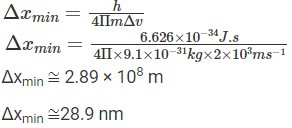Practice Questions on Heisenberg Uncertainty Principle | Physical Chemistry PDF Download
Q.1. Heisenberg’s uncertainty principle rules out the exact simultaneous measurement of ______ and ______.
Position and velocity.
It is impossible to accurately determine the position velocity of a small microscope particle such as an electron, proton, or neutron at the same time.
Q.2. The particles that are indistinguishable and obeys Heisenberg uncertainty principle and don’t obey Pauli’s exclusion principle are ______.
The particles that are indistinguishable and obeys Heisenberg uncertainty principle and don’t obey Pauli’s exclusion principle are Bose-Einstein statistics.
Q.3. If the uncertainty in the velocities of two particles A and B with masses of 1.0 × 10-27 kg and 1.0 × 10-31 kg, respectively, is the same, what will be the ratio of uncertainty in their positions?
ΔxAmAΔvA = ΔxBmBΔvB
Given, ΔvA = ΔvB
Therefore, ΔxAmA = ΔxBmB
ΔxA1.0 × 10-27 kg = ΔxB1.0 × 10-31 kg
ΔxA / ΔxB = 1.0 × 10-31 kg/1.0 × 10-27 kg = 1/10000.
Q.4. Which scientists developed the uncertainty principle and the concept of matter’s wave nature?
Heisenberg and de Broglie developed the uncertainty principle and the concept of matter’s wave nature.
Q.5. What is the order of wavelength associated with a 200g golf ball moving at a speed of 5mh–1.
The wavelength associated with a golf ball can be calculated as:
Q.6. What does the Heisenberg uncertainty principle imply?
According to Bohr’s theory, an electron is a material particle. Its position and momentum can be calculated precisely. However, when an electron is considered in the form of a wave, as proposed by de-Broglie, it is not possible to determine the exact position and velocity of the electron at a given instant because the wave extends across a region of space.
Werner Heisenberg proposed the Heisenberg uncertainty principle in 1927, which states that “it is impossible to measure simultaneously the exact position and exact momentum of a body as small as an electron.”
Q.7. Suppose the velocity of an electron in an atom is known to have an accuracy of 2 × 103 ms–1 (reasonably accurate compared with orbital velocities). What is the electron’s minimum uncertainty in position, and how does this compare with the approximate 0.1 nm size of the atom?
Given- Δv = 2 × 103 ms–1
Mass of an electron, m = 9.1 × 10–31 kg
Plank’s constant, h = 6.626 × 10–34 J.s
According to Heisenberg Uncertainty Principle
Where p is the momentum, p = mv
Therefore, minimum uncertainty in the position can be calculated as:
Size of the atom, x = 0.1 nm
Therefore, the ratio of uncertainty in the position with the size of the atom is-
Δx/x = 28.9 nm/0.1 nm
Δx/x = 289
Hence, the uncertainty in the position is 289 times the size of the atom.
Q.8. What are the limitations of Heisenberg’s Uncertainty Principle?
According to Heisenberg’s uncertainty principle, “it is impossible to calculate the position and momentum of a small moving object like an electron simultaneously and accurately.” The principle only applies to microscopic particles and not to macroscopic particles.
Q.9. Why is it impossible to measure position and momentum at the same time?
Consider the measurement of an electron’s position to demonstrate Heisenberg’s uncertainty principle. A photon must collide with an object and return to the measuring device in order to determine its position. Since photons have finite momentum, a momenta transfer will occur when the photon collides with the electron. The electron’s momentum will increase as a result of this momenta transfer. As a result, any attempt to measure a particle’s position increases the uncertainty in the value of its momentum.
Q.10. What will be the uncertainty in the position of an electron (mass = 9.10–31 kg) moving at 300 ms–1 with an accuracy of 0.001 percent?
Given- m = 9.10–31 kg, h = 6.62 × 10–34 J.s, v = 0.003 m/s
According to Heisenberg Uncertainty Principle
On substituting the values, we will get
|
83 videos|142 docs|67 tests
|




























